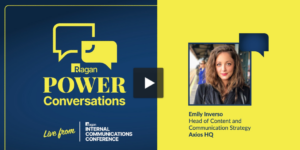How to prevent jargon monoxide and minimize employee friction
Takeaways for communicators from the authors of ‘The Friction Project’.

Tom Corfman was fixing friction long before anyone came up with the term. That’s why he runs the Build Better Writers program at RCG, where he’s a senior consultant.
For a book about business administration, “The Friction Project” offers a surprising amount of advice about internal communications.
Or maybe not. The book “is about forces that make it harder, slower, more complicated, or downright impossible to get things done in organizations,” according to the authors, two professors at Stanford University’s Graduate School of Business. Poor communication is often a big barrier.
Using language sometimes unsuited for polite company, Robert Sutton and Huggy Rao take aim at many features of corporate life, from unbearable meetings to ill-conceived initiatives, which they call “friction.” These are obstacles that “chip away at our initiative, commitment and zest for work.”
“Friction fixers” is their name for employees, managers and leaders who aim to remove such obstacles.
Here are eight tips on communication from “The Friction Project.”
Note: Some readers may object to the language Sutton and Rao use to illustrate their points, which we quote twice.
1. “Short, crisp paragraphs.” Sutton and Rao point out that their call for clarity is hardly new. In August 1940, three months after becoming prime minister, Winston Churchill sent his 234-word “Brevity” memo to his War Cabinet.
“To do our work, we all have to read a mass of papers,” he wrote. “Nearly all of them are far too long. This wastes time, while energy has to be spent in looking for the essential points.”
“The discipline of setting out the real points concisely will prove an aid to clearer thinking,” he wrote.
2. Monoxide detector. Churchill disapproved of “officialese jargon.” The authors devote a chapter to gleefully exposing the executives and consultants who are constantly spouting corporate gobbledygook.
To help readers more quickly recognize such noxious nonsense, Sutton and Rao helpfully list the four primary categories of such babble: Convoluted crap, meaningless bullshit, in-group lingo and jargon mishmash syndrome.
Not content to just condemn, Sutton and Rao provide examples of “powerful words” that prompt others “to act, persist and generate imaginative solutions.”
3. Respect people’s time. We focus on clear language to get people’s attention. We want them to understand what we want them to know.
But Sutton and Rao look at it from the perspective of the audience. Jargon monoxide and other forms of friction waste time.
“A hallmark of skilled friction fixers: being a trustee of other people’s time,” they write.
Respect for other people’s time might add urgency to our efforts at clear communication.
4. George Carlin’s stuff. “We humans can’t resist adding more and more stuff to our workplaces: staff, space, gizmos, software, meetings, emails, Slack threads, rules, training, the latest management fad,” the authors write. ‘We are wired to see stuff we add as righteous and essential. And to see stuff that others add as annoying and unnecessary.”
They quote the late comedian who summed this up when he said, “My shit is stuff. Your stuff is shit.”
Corporate communicators are no exception. We’re great at adding channels of communication and then filling up those channels. Not so good at subtracting.
Their solution? A seven-step “Good Riddance Review.”
5. It grows back. To cut down on needless meetings at Dropbox, CEO Drew Houston in 2013 removed nearly all standing meetings from employees’ calendars, calling it “Armeetingeddon.” No new meeting could be scheduled for two weeks after guidelines on scheduling meetings were issued.
The results were great, but two years later “things were worse than ever,” Houston said. Reducing the number of meetings is like mowing the lawn, he said.
Likewise, when Churchill returned as prime minister in 1951 after a five-year hiatus, he reissued his brevity memo.
“Official papers are too long and diffuse,” he said.
Or consider the company that wants to cut down on single-topic emails to employees (good idea) by creating a newsletter (good solution) only to see emails creep into the mix. Effective communication takes constant effort.
6. Human shield. Comms teams are often inundated with requests from all corners of the company to publicize things of little interest. Effective team leaders shield their teams from such time-consuming requests.
Sutton and Rao write: “Part of a leader’s job is to take the heat, battle back, and turn murky and conflicting demands into clear expectations to protect their people from intrusions, confusion, aggravation, time sinks, and idiocy from on high so they can focus on their work.”
7. Good friction. Shielding is an example of “good friction,” which makes wrong things harder, like fulfilling comms requests with little merit.
Another example is clear rules. A secretary for a public works department said her city’s detailed snow-removal policy helped her explain to residents who were angry because their street hadn’t been plowed.
“I can refer citizens to our snow procedures and show they are not being picked on,” she said.
For that same reason, we urge comms teams to establish editorial guidelines to cut down on busywork requests and focus on the most important message.
8. Seinfeld’s tip. Sutton and Rao are by no means slaves to efficiency. In 2017, the Harvard Business Review asked Jerry Seinfeld if a consulting firm like McKinsey & Co. could devise a more sustainable way to create comedy than the traditional writers’ room.
Seinfeld: Who’s McKinsey?
Review: It’s a consulting firm.
Seinfeld: Are they funny?
Review: No.
Seinfeld: Then I don’t need them. If you’re efficient, you’re doing it the wrong way. The right way is the hard way.
Sutton and Rao write, “Seinfeld’s belief that streamlining creativity can kill it is bolstered by piles of studies.”
Effective communication, especially even about mundane matters like benefits enrollment, requires creativity.
For those who look to AI as a shortcut to creativity: Keep looking.
Follow RCG on LinkedIn .






